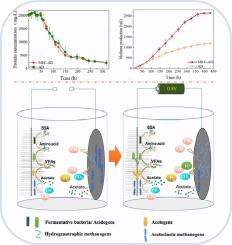Water Research ( IF 11.4 ) Pub Date : 2021-06-04 , DOI: 10.1016/j.watres.2021.117325 Lei Zhao , Xue-Ting Wang , Ke-Yang Chen , Zi-Han Wang , Xi-Jun Xu , Xu Zhou , De-Feng Xing , Nan-Qi Ren , Duu-Jong Lee , Chuan Chen

|
Anaerobic digestion (AD) is a promising technology capable of converting waste matter into bio-energy. Recent studies have reported that microbial electrolysis cell assisted anaerobic digestion (MEC-AD) is an effective system for methane production from organic waste, via enhanced electron transfer. However, little is known about the effects of applied voltage on the AD of proteins. Herein, the mechanism of MEC-AD on protein digestion was investigated using varying concentrations of bovine serum albumin (BSA) as the protein substrate (500 mg/L, 4 g/L, and 20 g/L BSA). Experimental results showed that the applied voltage can not only enhance the methane production rate from 23.8% to 45.6% at low and medium organic loading (BSA concentration of 500 mg/L and 4 g/L), but also improve the methanogenesis efficiency increased by 225.4% at high BSA concentration (20 g/L) with the applied voltage of 0.6 V compared to that with open circuit. Mechanism explorations revealed that the applied voltage significantly enhanced the acidogenesis and methanogenesis processes in the AD of proteins. Microbial community characterization showed that with the applied voltage, the abundance of fermentative bacteria increased by 46.7 % at the anode, while, the abundance of Methanobacterium at the cathode increased from 10.4 to 84.3%, indicating the methanogenesis pathway transformed from acetoclastic to hydrogenotrophic. External circuit electron transfer calculations demonstrated that only 10% of the produced methane could be attributed to direct interspecies electron transfer (DIET). From a thermodynamic perspective, the applied external voltage led to a reduction in the cathodic potential to -0.9 V, which is beneficial for enhanced methane production via mediated interspecies electron transfer (MIET) by enrichment of hydrogenotrophic methanogens. The findings reported here reveal the previously unrecognized contribution of proteins to MEC-AD, while also furthering our understanding of the role of applied voltage in the MEC-AD process.
中文翻译:

使用微生物电解池辅助蛋白质厌氧消化(MEC-AD)提高甲烷产量的潜在机制
厌氧消化 (AD) 是一种很有前途的技术,能够将废物转化为生物能源。最近的研究报告称,微生物电解池辅助厌氧消化 (MEC-AD) 是一种通过增强电子转移从有机废物中生产甲烷的有效系统。然而,关于施加电压对蛋白质 AD 的影响知之甚少。在此,使用不同浓度的牛血清白蛋白 (BSA) 作为蛋白质底物 (500 mg/L、4 g/L 和 20 g/L BSA) 研究了 MEC-AD 对蛋白质消化的机制。实验结果表明,在中低有机负荷下(BSA 浓度分别为 500 mg/L 和 4 g/L),施加电压不仅可以将甲烷产率从 23.8% 提高到 45.6%,而且可以提高产甲烷效率。 225. 与开路相比,在高 BSA 浓度 (20 g/L) 和 0.6 V 的施加电压下为 4%。机制探索表明,施加的电压显着增强了蛋白质 AD 中的酸化和产甲烷过程。微生物群落表征表明,随着施加电压,阳极发酵细菌的丰度增加了 46.7%,而甲烷在阴极从10.4提高到84.3%,这表明转化从乙酸分解到氢营养的产甲烷途径。外电路电子转移计算表明,产生的甲烷中只有 10% 可归因于直接种间电子转移 (DIET)。从热力学的角度来看,施加的外部电压导致阴极电位降低至-0.9 V,这有利于通过富集氢营养产甲烷菌的介导种间电子转移(MIET)提高甲烷产量。此处报告的发现揭示了蛋白质对 MEC-AD 的先前未被认识的贡献,同时也进一步加深了我们对外加电压在 MEC-AD 过程中的作用的理解。











































 京公网安备 11010802027423号
京公网安备 11010802027423号